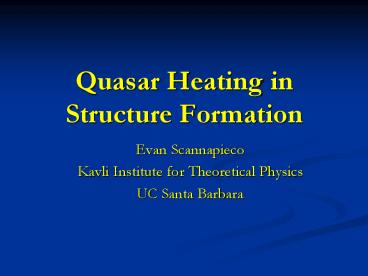Quasar Heating in Structure Formation - PowerPoint PPT Presentation
1 / 32
Title:
Quasar Heating in Structure Formation
Description:
OpenMP version of the Hydra' SPH code (Pearce & Couchman 1997, Thacker et al ... (Hydra) Entropy evolution (slice from simulation) Rendered on 13403. grid. ... – PowerPoint PPT presentation
Number of Views:29
Avg rating:3.0/5.0
Title: Quasar Heating in Structure Formation
1
Quasar Heating in Structure Formation
- Evan Scannapieco
- Kavli Institute for Theoretical Physics
- UC Santa Barbara
2
Rob Thacker Queens University
Peng Oh UC Santa Barbara
Hugh Couchman McMaster University
Marc Davis UC Berkeley
3
What Determines L?
RDCS1252 (z1.23), Rosati etal (2004)
Moore etal (1999)
4
A Classic Argument
Rees Ostriker (1977)
Dekel Silk (1986)
Problem 1 Overcooling (25-40 condensed)
nkT ??n2
gt thubble
? ?
(Suginohara Ostriker 1998 Lewis et al 2000
Thacker et al 2000 Davé et al 2001)
For virial density today, Gives few times 1012
5
Prob 2 Antihierarchical Evolution
6
AGN in the X-ray
Ueda etal 2004
7
B-band Quasar Luminosity Function
Wyithe Loeb (2003) see also Kauffmann
Haehnelt
Every 31 merger lights a quasar. Each
shines at its Eddington luminosity for a time
proportional to the dynamical time of the galaxy.
Mbh ? vc,3005
Ferrarese (2002)
8
Clusters X-ray Emission
LX M ?gas T1/2 T M2/3 ?DM1/3 LX ?gas
?DM-1/2 T2 Virialized Gas Lx T2
1 keV 100 keV cm2
Preheated Gas ?gas ?i (T/Ti)3/2 Lx
T7??
Kaiser (1991)
Mushotzky and Scharf 1997
9
AGN Heating
Radio jets
10
3C47, Leahy (1996)
BAL Winds
All
Murray, Chiang, Grossman, Voit 1995
10
ES Oh (2004) model
- Some small fraction of an AGNs luminosity is
converted to mechanical input associated with
jets or winds. - Energy deposited into a thin shell (Sedov-Taylor
blast) - Post-shock entropy of the IGM directly impacts
growth of further generations, if it heat things
to the point that cooing can not occur within a
Hubble time, then you stop forming stars.
11
ES Oh (2004) model
12
Predictions
Dotted lines stradle outflow efficiencies of 2.5
and 10, central blue line is 5 Big galaxies
host large quasars, and can recover from feedback
at only at high redshift.
13
Simulation Modeling
Thacker, ES Couchman 2006, in prep
Again quasars are associated with 31
mergers, But now with a BH mass calculated from
gas mass 5 of energy in light is put into outflow
- Modification of work done on SN outflows
(ES, Thacker, Davis 2001, Thacker, ES, Davis
2002)
Outflows are modeled as thin spherical shells
Host galaxy remains intact.
14
Code Details
- OpenMP version of the Hydra SPH code (Pearce
Couchman 1997, Thacker et al 2003, Thacker
Couchman, 2006) - 2x 6403 mass elements (half gas, half dark
matter) - Largest SPH simulation ever carried out at that
time - 147 h-1 Mpc box, mass resolution
- 2.2x108 baryons, 1.2x109 DM
- 140,000 cpu hours, down to
- z1.2
- Run on 256 processor WestGrid, Alberta CA
- Total disk output 5 TB (1/5th size of
Millennium Run)
Locally adaptive Fourier-mesh scheme
15
(No Transcript)
16
Galaxy Clusters
1046
1044
LX
1042
LX?T3.2
1040
Temperature/ keV
17
Quasar Luminosity Function
18
Fundamental differences between the semi-analytic
simulation models
- 1.) In the simulation we dont eject the gas from
the quasar host galaxy itself. This gas isnt
counted in the semianalytic model. - 2.) In simulation shock the surrounding material
that has substructure. Effect of shock impacting
uniform cloud versus cloud with substructure are
very different. OVERCOOLING! - IF 1 we need to do more than stop accretion
- IF 2 we need either need more feedback, or.
19
Naab, Ostriker et al (2006)
20
Quasar-Galaxy cross correlation function
S
- Bluegg
- Redqg
- HashDEEP2 (from Coil etal 06)
- blue line 2x1012 DM halos
- Could this be
- 3-body interactions?
Seen in SDSS (Serber etal 2006)
21
Dynamical Friction
22
Dynamical Friction
23
Three-body interactions
24
Conclusions
- Semianalytical models show that quasars outflows
- are a promising explanation for the
antihierarchical behavior of galaxy and quasars,
and the properties of clusters. - Simulations
- Merger model reproduces correlation function of
quasars very well. - Cross-correlation function shows enhancement at
small separations, probably due to 3 body
interactions, may be a diagnostic of
merger-nature - Lx-T is well reproduced
- Luminosity function less well reproduced In-sho
ck cooling? ISM physics? (probably both are
true)
25
(No Transcript)
26
Entropy final state
Thanks to Jon Johansson, CNS, U. of Alberta
27
Galaxies and Stars
28
Why dont we use Gadget2?
Multiple time-step capability in G2 is very
efficient
Final epoch for this project
Total wallclock
G2 is rather inefficient at high z
(Hydra)
Simulation time
29
Entropy evolution (slice from simulation)
Rendered on 13403 grid. Simulation used 0.5x109
particles (half hydro, half dark
matter). Dynamic range 6000
30
Critical Entropy
Oh Benson (2003)
31
Heating Sources
1 keV/Baryon 2?1058 ergs/M12(gas)
Supernovae M/300 ?1051 ??
? ? 3?1060 ergs ? M12()
AGN Mbh c2? 1.8?1054 ? 1.6?108 vc,3005
? ? ? 1063 ergs ? M12(gas)5/3
32
Correlation function of Quasars
Bluesim
2dF results (Croom et al 2001)
- Our simulation agrees with the observed turn-up
in the small scale clustering of quasars - CF is explained by the halo model of clustering
- No need for special physics
Sloan binary quasar data (Hennawi et al 2005)































